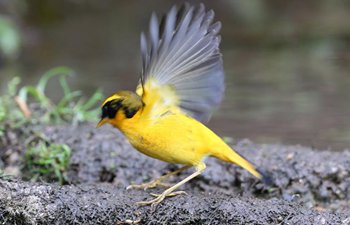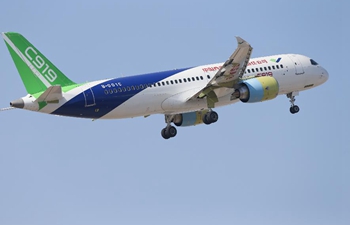WASHINGTON, Dec. 20 (Xinhua) -- U.S. space agency NASA announced Wednesday that it has selected two finalist concepts for a robotic mission planned to launch in the mid-2020 to explore the solar system.
One finalist, known as Comet Astrobiology Exploration Sample Return (CAESAR), seeks to return a sample from 67P/Churyumov-Gerasimenko, a comet that was successfully explored by the European Space Agency's Rosetta spacecraft, to determine its origin and history, NASA said in a statement.
The other, called Dragonfly is a drone-like rotorcraft that would explore the prebiotic chemistry and habitability of dozens of sites on Saturn's moon Titan, an ocean world in our solar system, it said.
The concepts were chosen after an extensive and competitive peer review process from 12 proposals submitted in April under a New Frontiers program announcement of opportunity, it said.
"This is a giant leap forward in developing our next bold mission of science discovery," said Thomas Zurbuchen, associate administrator for NASA's Science Mission Directorate. "These are tantalizing investigations that seek to answer some of the biggest questions in our solar system today."
The CAESAR and Dragonfly missions will receive funding through the end of 2018 to further develop and mature their concepts.
NASA said it plans to select one of these investigations in the spring of 2019 to continue on to subsequent mission phases.
The selected mission will be the fourth in NASA's New Frontiers portfolio, a series of principal investigator-led planetary science investigations that fall under a development cost cap of approximately 850 million U.S. dollars.
Its predecessors are the New Horizons mission to Pluto and a Kuiper Belt object known as 2014 MU69, the Juno mission to Jupiter, and the OSIRIS-REx asteroid sample return mission, now heading to the asteroid Bennu for arrival in 2018.
NASA also announced the selection of two mission concepts that will receive technology development funds to prepare them for future mission competitions.
One is Enceladus Life Signatures and Habitability (ELSAH), which will receive funds to develop cost-effective techniques that limit spacecraft contamination and thereby enable life detection measurements on cost-capped missions.
The other is Venus In situ Composition Investigations (VICI), which will further develop the Venus Element and Mineralogy Camera to operate under the harsh conditions on Venus.
The instrument uses lasers on a lander to measure the mineralogy and elemental composition of rocks on the surface of Venus, NASA added.

















